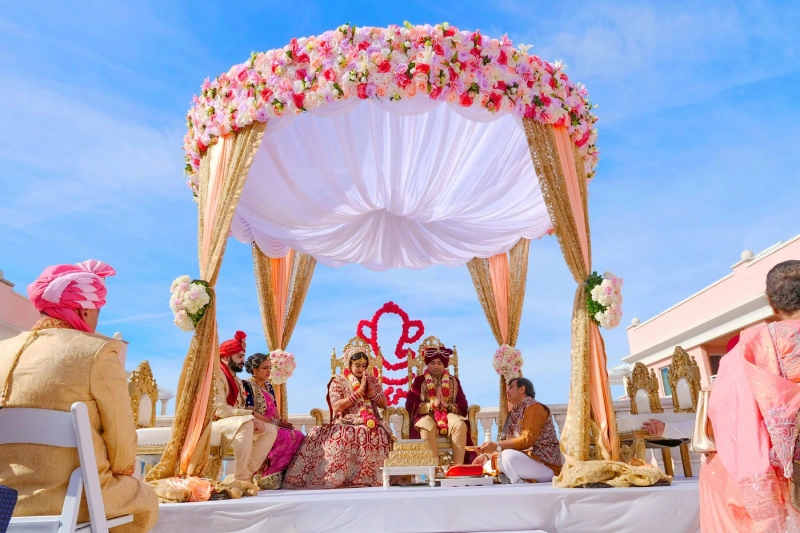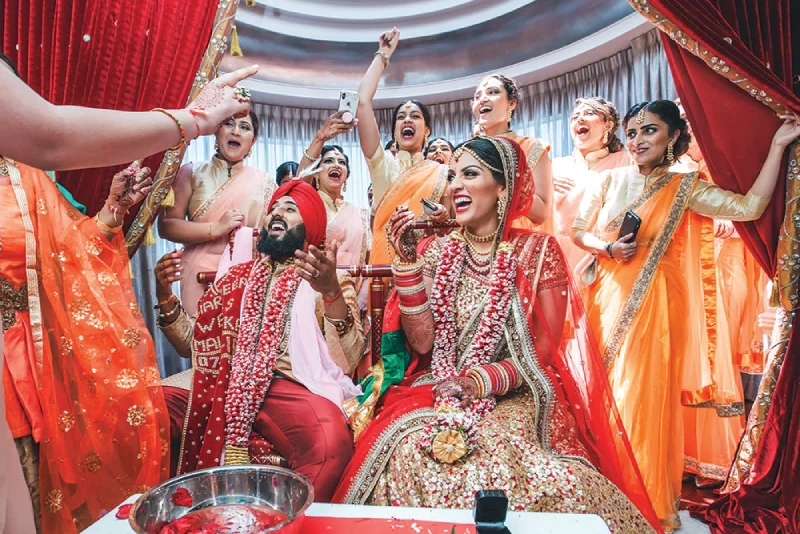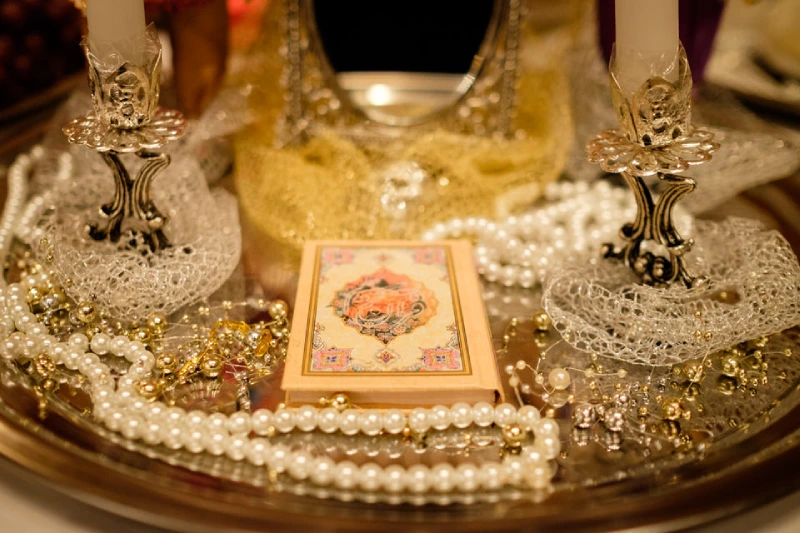Weddings are a celebration of love, but when two rich cultural heritages intertwine, the event transforms into an extraordinary spectacle. The fusion of Persian traditions with Indian elements creates a breathtaking tapestry of colors, rituals, and emotions. Imagine the enchanting melodies of a Persian serenade mingling with the vibrant beats of Indian dance, each moment steeped in meaning and history. From the stunning artistry of henna designs to the elegance of the Persian sofreh, this cultural blend offers something truly unique. Couples embracing this fusion are not just celebrating their love; they are honoring their diverse backgrounds, creating a beautiful narrative that speaks to the heart. In this article, we will explore the intricate details and enchanting traditions that emerge when Persian elegance meets Indian vibrancy, inviting you to experience the magic of this remarkable union. Discover how this cultural fusion is more than just a wedding; it’s a celebration of unity, love, and the shared stories that bind us all.
Historical Context of Cultural Fusion in Weddings
The concept of cultural fusion in weddings is not a new phenomenon. Throughout history, the blending of different traditions and customs has often been a result of cross-cultural interactions, migrations, and the unification of diverse communities through marriage. This amalgamation of cultural elements creates a unique and enriching experience, serving as a bridge that connects varied backgrounds and traditions. Historically, such unions have contributed to the exchange of ideas, art, and rituals, enriching the cultural tapestry of societies.
Persian and Indian cultures, both marked by their ancient histories and rich traditions, have had a substantial influence on each other over the centuries. The Silk Road, which facilitated trade between the Persian Empire and the Indian subcontinent, also allowed for the exchange of cultural practices and ideas. Marriages between these two cultures have often symbolized the convergence of two great civilizations, each bringing its own set of practices, beliefs, and aesthetics to the table. This historical context sets the stage for understanding the beautiful blend of Persian and Indian elements in modern weddings.
In contemporary times, the fusion of Persian and Indian wedding traditions has gained popularity as couples seek to honor their diverse heritages. This cultural blend not only highlights the uniqueness of each tradition but also emphasizes the universal themes of love, unity, and respect. The combination of Persian elegance and Indian vibrancy creates a wedding experience that is both deeply meaningful and visually spectacular, making it a cherished memory for the couple and their families.
Key Elements of a Traditional Persian Wedding
A traditional Persian wedding, or “Aroosi,” is a grand affair filled with elaborate rituals and ceremonies that are steeped in symbolism and history. One of the most significant aspects of a Persian wedding is the “Sofreh Aghd,” a beautifully arranged spread that includes various items symbolizing health, prosperity, and fertility. The Sofreh Aghd typically features a mirror, candles, flowers, sweets, and a Quran or a book of poetry, each representing different aspects of the couple’s journey together.
The wedding ceremony itself is a formal and elegant event. It often begins with the “Aghd,” the legal and religious contract that binds the couple. During the Aghd, the bride and groom sit before the Sofreh Aghd while the officiant recites the marriage vows. The presence of close family members and friends is essential, as their collective energy and blessings are believed to bring good fortune to the newlyweds. The Aghd is followed by the “Jashn,” a lively celebration filled with music, dance, and feasting.
Another key element of a Persian wedding is the “Khastegari” or the formal proposal, where the groom’s family visits the bride’s family to seek her hand in marriage. This tradition underscores the importance of family approval and support in Persian culture. Additionally, Persian weddings often feature traditional music and dances, such as the “Raghse Chaghoo,” a knife dance performed before the couple cuts the wedding cake. These elements collectively create a rich and memorable experience that honors Persian heritage.
Essential Features of an Indian Wedding Ceremony
Indian weddings are known for their grandeur, vibrant colors, and intricate rituals that vary significantly across different regions and communities. One of the most essential features of an Indian wedding is the “Saptapadi” or the seven steps, where the bride and groom take seven vows while walking around a sacred fire. Each step represents a promise the couple makes to each other, emphasizing values such as loyalty, mutual respect, and lifelong companionship.
The “Haldi” ceremony is another integral part of Indian weddings, where a turmeric paste is applied to the bride and groom. This ritual is believed to purify and bless the couple, and it also symbolizes the beginning of their new life together. The vibrant yellow of the turmeric paste adds to the festive atmosphere and is often accompanied by traditional songs and dances performed by family members.
Indian weddings also place significant emphasis on attire and jewelry. The bride typically wears a richly embroidered saree or lehenga, adorned with intricate jewelry and henna designs on her hands and feet. The groom’s attire, often a sherwani or a traditional dhoti, is equally elaborate, reflecting the opulence of the occasion. The wedding ceremony is usually followed by a lavish reception, where guests enjoy an array of delectable dishes and participate in joyous celebrations, including music and dance performances.
How to Incorporate Persian Elements into Indian Weddings
Incorporating Persian elements into an Indian wedding can create a harmonious blend that honors both cultural heritages. One way to achieve this is by integrating the Sofreh Aghd into the traditional Indian wedding setup. The Sofreh Aghd can be placed alongside the sacred fire used in Indian ceremonies, symbolizing the union of the two cultures. Items on the Sofreh Aghd, such as the mirror, candles, and sweets, can be chosen to complement the Indian wedding decor, creating a visually stunning and meaningful display.
Another way to incorporate Persian elements is by including Persian music and dance in the wedding celebrations. Traditional Persian dances, such as the “Baba Karam” or “Bandari,” can be performed during the sangeet or reception, adding a unique flair to the festivities. Additionally, Persian musical instruments like the tar or santur can be played alongside Indian instruments, creating a beautiful fusion of melodies that resonate with the guests.
The inclusion of Persian culinary delights can also enhance the wedding experience. Persian dishes such as kebabs, saffron rice, and baklava can be served alongside traditional Indian dishes, offering guests a diverse and delectable dining experience. The fusion of Persian and Indian flavors not only adds to the culinary richness of the wedding but also symbolizes the harmonious blending of the two cultures. By thoughtfully incorporating these elements, couples can create a wedding that is both unique and deeply meaningful.
Unique Rituals: Combining Persian and Indian Wedding Customs
Combining Persian and Indian wedding customs involves creating a seamless blend of rituals that honor both traditions. One unique way to achieve this is by performing the “Saptapadi” around the Sofreh Aghd. As the couple takes their seven vows, they can incorporate elements from both cultures, such as reciting Persian poetry or prayers along with the traditional Indian vows. This fusion of rituals emphasizes the unity and shared values of the couple.
Another unique ritual that can be incorporated is the “Mehendi” ceremony, where intricate henna designs are applied to the bride’s hands and feet. This Indian tradition can be complemented by the Persian custom of “Hanna Bandan,” where henna is also applied to the groom’s hands. By combining these two rituals, the couple can celebrate the beauty and significance of henna in both cultures, creating a shared experience that brings together their families and friends.
The “Khastegari” or formal proposal can also be integrated into the Indian pre-wedding ceremonies. This Persian tradition can be performed alongside the “Roka” or “Shagun,” where the groom’s family formally accepts the bride into their family. By combining these customs, the couple can honor the importance of family approval and blessings in both cultures. These unique rituals create a wedding experience that is rich in symbolism and deeply meaningful for everyone involved.
Fashion and Attire: Blending Persian and Indian Styles
Fashion and attire play a crucial role in weddings, and blending Persian and Indian styles can create a stunning visual impact. The bride can opt for a fusion outfit that combines elements of both cultures, such as a lehenga with Persian-inspired embroidery or a saree with intricate Persian motifs. The use of luxurious fabrics like silk, velvet, and brocade, along with rich colors such as red, gold, and emerald, can enhance the regal look of the bridal attire.
The groom’s attire can also reflect the cultural fusion by incorporating elements from both Persian and Indian styles. A sherwani with Persian-inspired embellishments or a traditional Persian robe paired with Indian accessories can create a sophisticated and unique look. The groom can also wear a turban or a hat that reflects the traditional headgear of both cultures, adding a touch of elegance to his outfit.
Jewelry and accessories play an essential role in completing the bridal look. The bride can choose to wear traditional Indian jewelry, such as a maang tikka and choker, along with Persian-inspired pieces like a “farvahar” pendant or a “ghalamzani” bracelet. The combination of these elements creates a harmonious blend that reflects the cultural heritage of both the bride and groom. By thoughtfully selecting their attire and accessories, the couple can create a wedding look that is both unique and deeply meaningful.
Culinary Delights: A Fusion of Persian and Indian Cuisine
Food is an integral part of any wedding celebration, and a fusion of Persian and Indian cuisine can create a memorable dining experience for the guests. The wedding menu can feature a mix of traditional dishes from both cultures, offering a diverse and delectable array of flavors. Persian dishes such as “Chelo Kebab,” “Fesenjan,” and “Sabzi Polo” can be served alongside Indian favorites like “Biryani,” “Butter Chicken,” and “Paneer Tikka,” creating a culinary feast that delights the senses.
The dessert table can also showcase a blend of Persian and Indian sweets, offering guests a variety of delectable treats. Persian desserts like “Baklava,” “Zoolbia,” and “Sholeh Zard” can be paired with Indian sweets such as “Gulab Jamun,” “Ras Malai,” and “Jalebi,” creating a sweet symphony of flavors that guests will savor. The use of ingredients like saffron, rose water, and cardamom in both Persian and Indian desserts adds a fragrant and exotic touch to the wedding menu.
To enhance the dining experience, the presentation of the food can also reflect the cultural fusion. Traditional Persian and Indian serving dishes, such as copper trays and brass utensils, can be used to present the food in an elegant and visually appealing manner. The use of decorative elements like flowers, candles, and intricate table settings can create a festive and inviting atmosphere that complements the culinary delights. By thoughtfully curating the wedding menu and presentation, couples can create a dining experience that is both unique and unforgettable.
Music and Dance: Celebrating with a Cultural Mix
Music and dance are essential components of any wedding celebration, and blending Persian and Indian elements can create an electrifying and joyous atmosphere. The wedding festivities can feature a mix of traditional and contemporary music from both cultures, offering a diverse and dynamic soundtrack for the celebrations. Persian musical instruments like the “Daf” and “Santur” can be played alongside Indian instruments like the “Sitar” and “Tabla,” creating a harmonious fusion of melodies that resonate with the guests.
The dance performances can also reflect the cultural fusion, with traditional Persian dances like the “Baba Karam” and “Bandari” being performed alongside Indian dances such as “Bharatanatyam,” “Bhangra,” and “Garba.” The sangeet or mehendi ceremony can feature a mix of Persian and Indian dance performances, with family members and friends participating in the joyous celebrations. This blend of dance styles not only adds to the festive atmosphere but also highlights the shared joy and unity of the couple and their families.
To create a truly memorable experience, couples can also consider hiring a DJ or live band that specializes in Persian and Indian music. This ensures that the wedding celebrations feature a seamless blend of both cultures, with guests enjoying a diverse and dynamic mix of music and dance. The combination of Persian and Indian elements creates an electrifying and joyous atmosphere that reflects the unique cultural heritage of the couple and their families.
Conclusion: The Beauty of Cultural Fusion in Weddings
In conclusion, the fusion of Persian and Indian elements in a wedding creates a celebration that is both deeply meaningful and visually spectacular. This cultural blend not only highlights the uniqueness of each tradition but also emphasizes the universal themes of love, unity, and respect. From the intricate rituals and stunning attire to the delectable cuisine and electrifying music and dance, every element of this fusion wedding reflects the rich cultural heritage of the couple and their families.
By thoughtfully incorporating elements from both Persian and Indian traditions, couples can create a wedding experience that honors their diverse backgrounds while celebrating their shared journey together. This cultural fusion is more than just a wedding; it’s a celebration of unity, love, and the shared stories that bind us all. It serves as a beautiful reminder that love knows no boundaries and that the blending of different traditions can create something truly magical and unforgettable.
As we continue to embrace and celebrate cultural diversity, the fusion of Persian and Indian wedding elements offers a unique and enriching experience for couples and their families. It creates a beautiful narrative that speaks to the heart, inviting us to appreciate the beauty and richness of our shared cultural heritage. Whether through the artistry of henna designs, the elegance of the Sofreh Aghd, or the vibrant beats of Indian dance, this cultural fusion creates a wedding experience that is truly one-of-a-kind.





